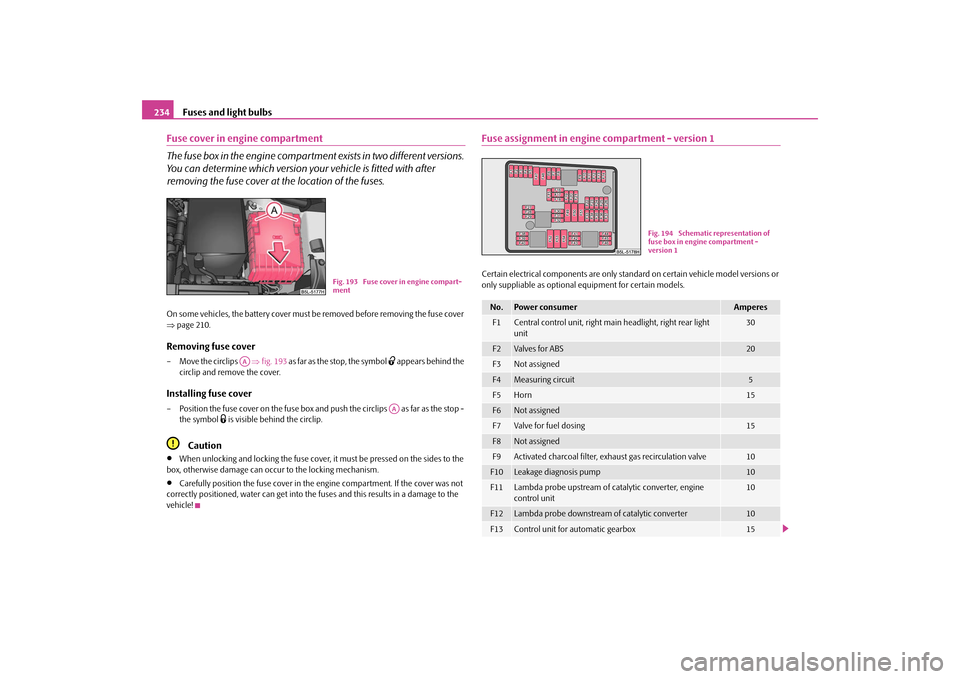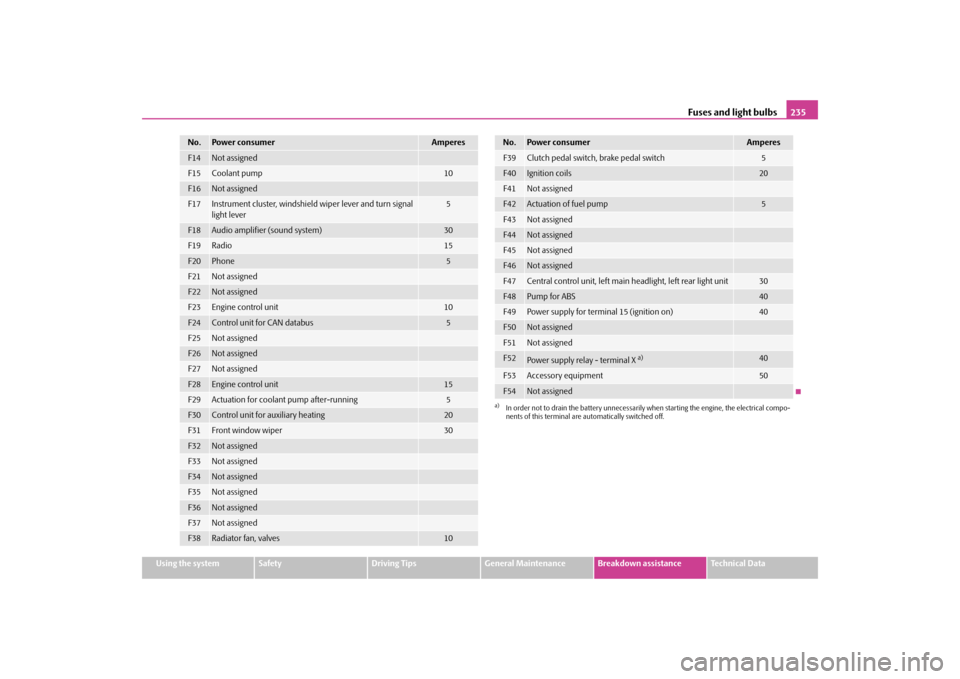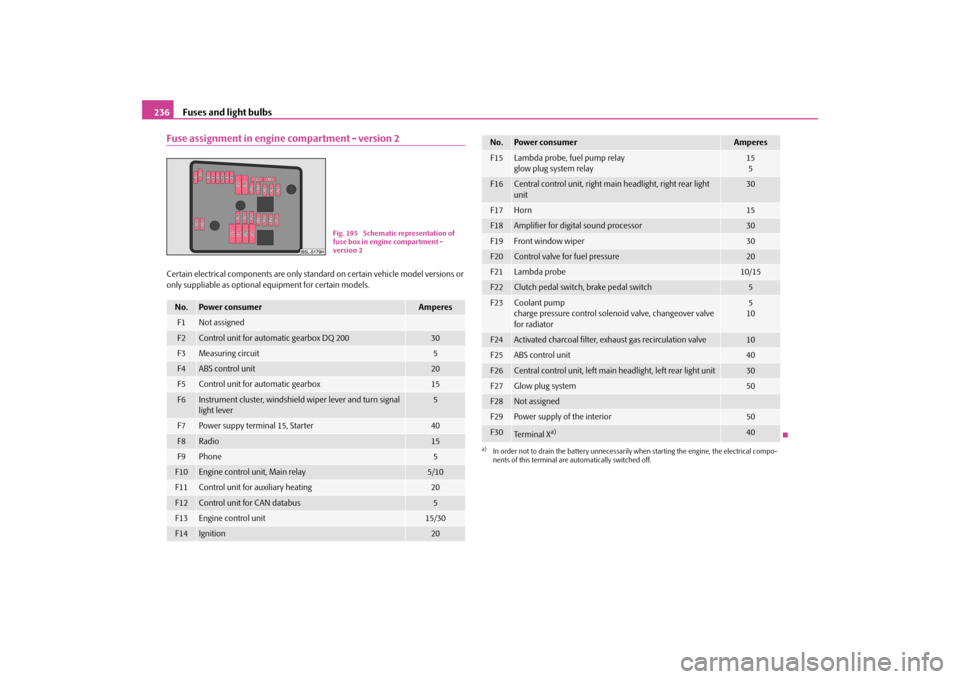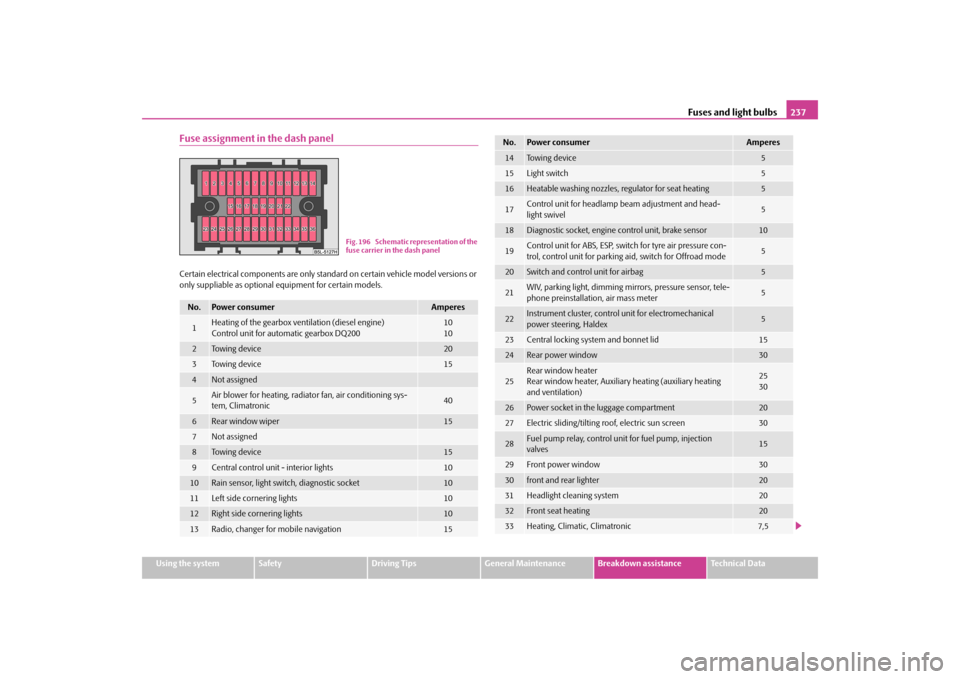SKODA YETI 2009 1.G / 5L Owner's Manual
Manufacturer: SKODA, Model Year: 2009, Model line: YETI, Model: SKODA YETI 2009 1.G / 5LPages: 271, PDF Size: 16.24 MB
Page 231 of 271

Breakdown assistance
230
WARNING
•
The non-insulated parts of the terminal clamps must never make contact
with each other. Furthermore, the cable connected to the positive terminal of the battery must not come into contact with electrically conducting parts of the vehicle - risk of a short circuit!•
Do not affix the jump starting cables to the negative terminal of the
discharged battery. There is
the risk of detonating gas seeping out the battery
being ignited by the strong spark which
results from the engine being started.
•
Run the jump-start cables so that they cannot be caught by any rotating
parts in the engine compartment.•
Do not bend over the batteries - risk of caustic burns!
•
The vent screws of the battery
cells must be tightened firmly.
•
Keep any sources of ignition (naked
flame, smouldering
cigarettes etc.)
away from the battery - risk of an explosion!•
Never jump-start the batteries which have a too low electrolyte level - risk
of explosion and caustic burns!Tow-starting and towing vehicleGeneralPlease pay attention to the following instru
ctions if you are going to use a tow rope:
Driver of the towing vehicle– Do not drive off until
the tow rope is taught.
– Release the clutch particularly gently wh
en starting off or depress the accelerator
particularly gently if yo
ur vehicle is fitted wi
th an automatic gearbox.
Driver of the towed vehicle– Switch the ignition on so that the steer
ing wheel is not blocked and you can also
operate the turn signal lights, the headlight flasher, the windscreen wipers and windscreen washer system.
– Take the vehicle out of gear or move the selector lever into position
N if your
vehicle is fitted with an automatic gearbox.
– Note that the brake servo unit and power steering only operate if the engine is
running. You will require significantly greater physical force to depress the brake pedal and to steer the vehicle
if the engine is not running.
– Ensure that the tow rope is always kept taught. Tow rope or tow bar A tow
bar
is safest way of towing a vehicle and also minimizes any shocks. You can use
a tow
rope
only if a suitable tow bar is not available.
The tow rope must be elastic to protect the
vehicle. Thus one shou
ld only use plastic
fibre rope or a rope made out
of a similarly elastic material.
Only attach the tow rope to the
towing eyes
provided for this purpose
⇒page 231
and
⇒page 231.
Driving style Towing another vehicle requires a certain am
ount of practice. Both drivers should be
familiar with the particular points about to
wing a vehicle. Unskilled drivers should not
attempt to tow in another vehicle or to be towed in. One should be constantly vigilant not to
allow impermissibly high
towing forces or
jerky loadings. There is always a risk of excessive stresses and damage resulting at the points to which you attach the tow rope or
tow bar when you attempt to tow a vehicle
which is not standing on a paved road.
Caution
If the gearbox of your vehicle no longer
contains any oil because of a defect, your
vehicle must only be towed in with the driven wheels raised clear of the ground, or on a special vehicle transporter or trailer.
Note
•
Please comply with any national legal provisions particularly regarding the
switched on signal systems, when towi
ng in or tow-starting another vehicle.
•
The tow rope must not be twisted as it may in certain circumstances result in the
front towing eye being unscrewed out of your vehicle.
sgg.6.book Page 230 Thursday, September 24, 2009 2:32 PM
Page 232 of 271

Breakdown assistance
231
Using the system
Safety
Driving Tips
General Maintenance
Breakdown assistance
Technical Data
Front towing eye The towing eye is stored in the box for the vehicle tool kit.Fig. 190 Front bumper: Removing the cover / installing the towing eye– Press on the upper half of the cover in direction of arrow
⇒fig. 190
.
– Pull the cover out of the front bumper. – Screw in the towing eye anticlockwise down to the stop
⇒fig. 190
and tighten up
using the wheel wrench (push the wheel wrench through eye).
– In order to reinstall the cover after screwing out the towing eye, first of all insert the
upper part of the cover and then press in the lower part. The cover must engage firmly.
Rear towing eyeFig. 191 Rear bumper: Removing the
cover / installing the towing eye
– Press on the upper half of the cover in direction of arrow
⇒fig. 191
.
– Take the cover out of the rear bumper
⇒fig. 191
.
– Screw in the towing eye anti
clockwise down to the stop
⇒fig. 191
and tighten up
using the wheel wrench (push the wheel wrench through eye).
– In order to reinstall the cover after screwing
out the towing eye, first of all insert the
upper part of the cover and then press in
the lower part. The cover must engage
firmly.
Towing in a vehicle fitted with a manual gearboxPlease refer to the notes
⇒page 230.
The vehicle can be towed in with a tow bar
or a tow rope or with the front or rear
wheels raised. The maximum towing speed is
50 km/h
.
Towing of a vehicle with an automatic gearboxPlease refer to the notes
⇒page 230.
The car can be towed in with a tow bar or
a tow rope. Refer at the same time to the
following guidelines:•
Move
selector lever into N
.
•
The maximum towing speed is
50 km/h
.
•
The maximum permissible towing distance is
50 km
. The gear oil pump does not
operate when the engine is not running; th
e gearbox would not be adequately lubri-
cated at higher speeds and over longer towing distance.
Note
The vehicle must be transported on a special vehicle or trailer if it is not possible to tow in the vehicle in the way described or if th
e towing distance is greater than 50 km.
Towing a vehicle with four-wheel drivePlease refer to the notes
⇒page 230.
A1
A1
sgg.6.book Page 231 Thursday, September 24, 2009 2:32 PM
Page 233 of 271

Breakdown assistance
232
The vehicle can be towed in using a tow bar or a tow rope or with the front axle raised. The maximum towing speed is
50 km/h
, the maximum permissible towing distance is
50 km
.Note
The vehicle must be transported on a special vehi
cle or trailer if it is not possible to tow
in the vehicle in the way described or if
the towing distance is greater than 50 km.
sgg.6.book Page 232 Thursday, September 24, 2009 2:32 PM
Page 234 of 271

Fuses and light bulbs
233
Using the system
Safety
Driving Tips
General Maintenance
Breakdown assistance
Technical Data
Fuses and light bulbsElectric fusesReplacing fuses Defect fuses must be replaced.Individual electrical circuits are protected by
fuses. The fuses are located on the left
side of the dash panel behind the safety
cover and under the cover in the engine
compartment on the left. – Switch the ignition off and also the electrical component affected. – Insert the wrench into the opening on the bottom side of the dash panel
⇒fig. 192
and remove the side cover or the cover in the engine compartment
⇒page 234.
– Find out which fuse belongs to the relevant component
⇒page 237, “Fuse assign-
ment in the dash panel”,
⇒page 234, “Fuse assignment in engine compartment -
version 1” or
⇒page 236, “Fuse assignment in engine compartment - version 2”.
– Take the plastic clip out of it
s fixture in the fuse cover, insert it onto the respective
fuse and pull out this fuse.
– Defect fuses can be detected by their melted metal strips. Replace the defect fuse
by a new fuse of the
same
ampere number.
– Fit on the fuse cover again.
We recommend that you always have the
small box of replacement fuses in your
vehicle. You can obtain repl
acement fuses from Škoda original accessories or from a
specialist garage
17).
Colour coding of fuses
Caution
•
Never attempt to “repair” fuses and also do
not replace them with a fuse of a higher
amperage - risk of fire! This may also caus
e damage at another part of the electrical
system.•
Have the electrical system checked as quickly as possible by a specialist garage if a
newly inserted fuse blows again after a short time.
Fig. 192 Fuse cover: left side of the dash panel
17)The small box with replacement fuses is part of
the basic equipping of th
e vehicle in some coun-
tries.
Colour
Maximum amperage
light brown
5
brown
7,5
red
10
blue
15
yellow
20
white
25
green
30
orange
40
red
50
sgg.6.book Page 233 Thursday, September 24, 2009 2:32 PM
Page 235 of 271

Fuses and light bulbs
234
Fuse cover in engine compartment The fuse box in the engine compartment exists in two different versions. You can determine which version your vehicle is fitted with after removing the fuse cover at
the location of the fuses.
On some vehicles, the battery cover must be removed before removing the fuse cover ⇒ page 210.Removing fuse cover– Move the circlips
⇒fig. 193
as far as the stop, the symbol
appears behind the
circlip and remove the cover.
Installing fuse cover– Position the fuse cover on the fuse box and
push the circlips as far as the stop -
the symbol
is visible behind the circlip.
Caution
•
When unlocking and locking the fuse cover, it must be pressed on the sides to the
box, otherwise damage can occur to the locking mechanism.•
Carefully position the fuse
cover in the engine compartment. If the cover was not
correctly positioned, water can get into the
fuses and this results in a damage to the
vehicle!
Fuse assignment in engine compartment - version 1Certain electrical components are only stan
dard on certain vehicle model versions or
only suppliable as optional
equipment for certain models.
Fig. 193 Fuse cover in engine compart- ment
AA
AA
No.
Power consumer
Amperes
F1
Central control unit, right main headlight, right rear light unit
30
F2
Valves for ABS
20
F3
Not assigned
F4
Measuring circuit
5
F5
Horn
15
F6
Not assigned
F7
Valve for fuel dosing
15
F8
Not assigned
F9
Activated charcoal filter, ex
haust gas recirculation valve
10
F10
Leakage diagnosis pump
10
F11
Lambda probe upstream of catalytic converter, engine control unit
10
F12
Lambda probe downstream
of catalytic converter
10
F13
Control unit for automatic gearbox
15
Fig. 194 Schematic representation of fuse box in engine compartment - version 1
sgg.6.book Page 234 Thursday, September 24, 2009 2:32 PM
Page 236 of 271

Fuses and light bulbs
235
Using the system
Safety
Driving Tips
General Maintenance
Breakdown assistance
Technical Data
F14
Not assigned
F15
Coolant pump
10
F16
Not assigned
F17
Instrument cluster, windshield
wiper lever and turn signal
light lever
5
F18
Audio amplifier (sound system)
30
F19
Radio
15
F20
Phone
5
F21
Not assigned
F22
Not assigned
F23
Engine control unit
10
F24
Control unit for CAN databus
5
F25
Not assigned
F26
Not assigned
F27
Not assigned
F28
Engine control unit
15
F29
Actuation for coolant pump after-running
5
F30
Control unit for auxiliary heating
20
F31
Front window wiper
30
F32
Not assigned
F33
Not assigned
F34
Not assigned
F35
Not assigned
F36
Not assigned
F37
Not assigned
F38
Radiator fan, valves
10
No.
Power consumer
Amperes
F39
Clutch pedal switch, brake pedal switch
5
F40
Ignition coils
20
F41
Not assigned
F42
Actuation of fuel pump
5
F43
Not assigned
F44
Not assigned
F45
Not assigned
F46
Not assigned
F47
Central control unit, left main headlight, left rear light unit
30
F48
Pump for ABS
40
F49
Power supply for terminal 15 (ignition on)
40
F50
Not assigned
F51
Not assigned
F52
Power supply relay - terminal X
a)
40
F53
Accessory equipment
50
F54
Not assigned
a)In order not to drain the battery unnecessarily wh
en starting the engine
, the electrical compo-
nents of this terminal are automatically switched off.No.
Power consumer
Amperes
sgg.6.book Page 235 Thursday, September 24, 2009 2:32 PM
Page 237 of 271

Fuses and light bulbs
236
Fuse assignment in engine compartment - version 2Certain electrical components are only standard on certain vehicle model versions or only suppliable as optional
equipment for certain models.
No.
Power consumer
Amperes
F1
Not assigned
F2
Control unit for automatic gearbox DQ 200
30
F3
Measuring circuit
5
F4
ABS control unit
20
F5
Control unit for automatic gearbox
15
F6
Instrument cluster, windshield
wiper lever and turn signal
light lever
5
F7
Power suppy terminal 15, Starter
40
F8
Radio
15
F9
Phone
5
F10
Engine control unit, Main relay
5/10
F11
Control unit for auxiliary heating
20
F12
Control unit for CAN databus
5
F13
Engine control unit
15/30
F14
Ignition
20
Fig. 195 Schematic representation of fuse box in engine compartment - version 2
F15
Lambda probe, fuel pump relay glow plug system relay
155
F16
Central control unit, right main headlight, right rear light unit
30
F17
Horn
15
F18
Amplifier for digital sound processor
30
F19
Front window wiper
30
F20
Control valve for fuel pressure
20
F21
Lambda probe
10/15
F22
Clutch pedal switch, brake pedal switch
5
F23
Coolant pump charge pressure control soleno
id valve, changeover valve
for radiator
5 10
F24
Activated charcoal filter, ex
haust gas recirculation valve
10
F25
ABS control unit
40
F26
Central control unit, left main
headlight, left rear light unit
30
F27
Glow plug system
50
F28
Not assigned
F29
Power supply of the interior
50
F30
Te r m i n a l X
a)
40
a)In order not to drain the battery unnecessarily wh
en starting the engine, the electrical compo-
nents of this terminal are automatically switched off.No.
Power consumer
Amperes
sgg.6.book Page 236 Thursday, September 24, 2009 2:32 PM
Page 238 of 271

Fuses and light bulbs
237
Using the system
Safety
Driving Tips
General Maintenance
Breakdown assistance
Technical Data
Fuse assignment in the dash panelCertain electrical components are only standard on certain vehicle model versions or only suppliable as optional
equipment for certain models.
No.
Power consumer
Amperes
1
Heating of the gearbox ve
ntilation (diesel engine)
Control unit for automatic gearbox DQ200
1010
2
To w i n g d e v i c e
20
3
To w i n g d e v i c e
15
4
Not assigned
5
Air blower for heating, radiat
or fan, air conditioning sys-
tem, Climatronic
40
6
Rear window wiper
15
7
Not assigned
8
To w i n g d e v i c e
15
9
Central control unit - interior lights
10
10
Rain sensor, light switch, diagnostic socket
10
11
Left side cornering lights
10
12
Right side cornering lights
10
13
Radio, changer for mobile navigation
15
Fig. 196 Schematic representation of the fuse carrier in the dash panel
14
To w i n g d e v i c e
5
15
Light switch
5
16
Heatable washing nozzles, regulator for seat heating
5
17
Control unit for headlamp be
am adjustment and head-
light swivel
5
18
Diagnostic socket, engine
control unit, brake sensor
10
19
Control unit for ABS, ESP, swit
ch for tyre air pressure con-
trol, control unit for parking aid, switch for Offroad mode
5
20
Switch and control unit for airbag
5
21
WIV, parking light, dimming mirrors, pressure sensor, tele- phone preinstallation, air mass meter
5
22
Instrument cluster, control
unit for electromechanical
power steering, Haldex
5
23
Central locking system and bonnet lid
15
24
Rear power window
30
25
Rear wind
ow heater
Rear window he
ater, Auxiliary heating (auxiliary heating
and ventilation)
25 30
26
Power socket in the luggage compartment
20
27
Electric sliding/tilting roof, electric sun screen
30
28
Fuel pump relay, control unit for fuel pump, injection valves
15
29
Front power window
30
30
front and rear lighter
20
31
Headlight cleaning system
20
32
Front seat heating
20
33
Heating, Climatic, Climatronic
7,5
No.
Power consumer
Amperes
sgg.6.book Page 237 Thursday, September 24, 2009 2:32 PM
Page 239 of 271

Fuses and light bulbs
238
For power consumers, e.g. the radio, which ca
n be operated with the ignition switched
off as long as the ignition key is not withdrawn. Electrically adjustable seats are protected by
automatic circuit breakers
, which
switch on again automatically after a few seconds after the overload has been eliminated.BulbsChanging bulbsThe relevant lamp must always be switch
ed off before a light bulb is replaced.
Defect light bulbs should only be replaced
with light bulbs of the same type. The desig-
nation is located on the ligh
t socket or the glass bulb.
Changing certain bulbs is not something whic
h you can do yourself, but requires to be
done by a specialist. Other parts of the vehicle must be removed in order to change the light bulbs. This applies, in particular, to
bulbs which can only be reached from the
engine compartment. We therefore recommend that you have any
bulbs changed by a specialist garage or,
in exceptional cases, by calling
on other professional assistance.
Please note that the engine compartment is a hazardous area
⇒page 204, “Working
in the engine compartment”. We recommend that you always have a small box of replacement bulbs in your vehicle. You can obtain replacement bulbs from Škoda
original accessories or from a specialist
garage
18).
The set of light bulbs can be stowed
in the box in the luggage compartment.
Fitted with a xenon headlightChange of bulbs on vehicles with Xenon lights (low beam lights, parking lights and main beam lights) should be undertaken by a specialist garage. Bulb - Overview
34
Alarm, spare horn
5
35
Control unit for automatic gearbox DQ200
10
36
Not assigned
18)The small box with replacement bulbs is part of
the basic equipping of th
e vehicle in some coun-
tries.No.
Power consumer
Amperes
Front headlight
Halogen headlight
Xenon headlight
Low beam light
H4
D1S
Main beam light
H4
D1S
Parking lights
W5W
W5W BL
Daylight driving lights
P13W
Turn signals
HPC24WY
Fog lights
H7
Rear light unit
Bulb
Reversing lights, brake lights and rear fog light
P21W
Turn signals
PY21W
Parking lights
W5W
Others
Bulb
Licence plate light
C5W
3. Brake light
LED
Entry lighting
W5W
front interior lighting
W5W
Reading lights
W5W
Rear interior lighting
C5W
sgg.6.book Page 238 Thursday, September 24, 2009 2:32 PM
Page 240 of 271

Fuses and light bulbs
239
Using the system
Safety
Driving Tips
General Maintenance
Breakdown assistance
Technical Data
WARNING
•
Bulbs H7 and H4 are pressurised and
may burst when changing the bulb -
risk of injury!•
It is recommended to wear gloves and
safety glasses when changing a bulb.
•
Gas discharge bulbs* (xenon bulbs) op
erate with a high voltage, profes-
sional knowledge is required - danger to life!
Caution
Do not take hold of the glass bulb with naked fingers (even the smallest amount of dirt reduces the working life of the light bulb).
Use a clean cloth, serviette or something
similar.
Note
This Owner's Manual only describes the replacement of bulbs where it is assumed that no major complications will
arise. Other light bulbs should be replaced by your
specialist garage.
Front headlightPositions of the light bulbs in the front headlight
⇒fig. 197
.
- Fog lights and daylight driving lights - Parking lights (Xenon headlight) - Parking lights (halogen headlight), low beam lights and main beam lightsTurn signal light at the frontYou should have the light bulb of the front
turn signal light replaced by a specialist
garage.Parking light at the frontFig. 198 Remove cap / removing the fixtur
e for the parking light (halogen headlight)
Luggage compartment light
W5W
Door warning light
W5W
Lighting in storage compartment on front passenger side
C3W
Others
Bulb
Fig. 197 Front headlight: Fitting position of the bulbs
AAABAC
sgg.6.book Page 239 Thursday, September 24, 2009 2:32 PM